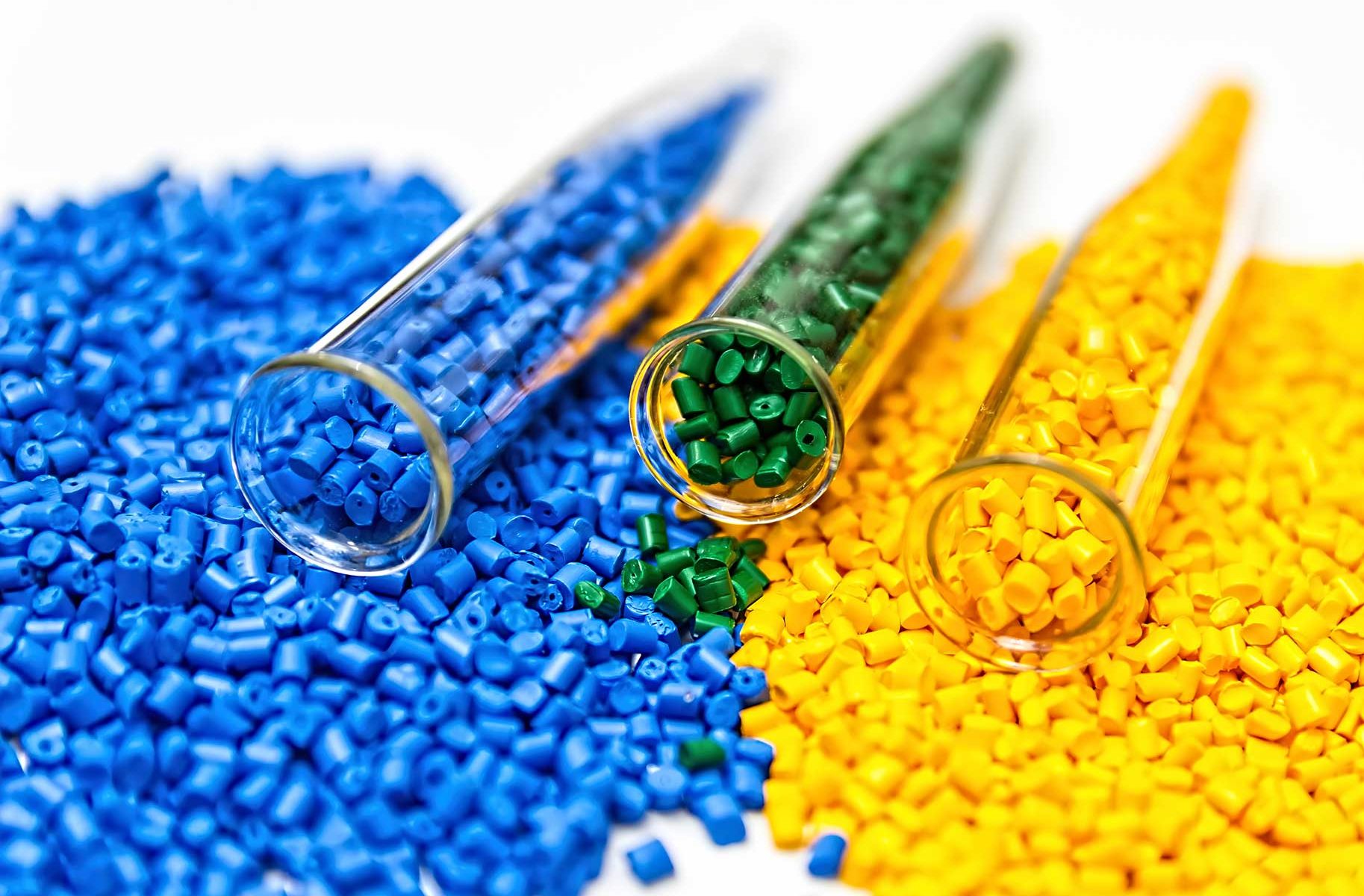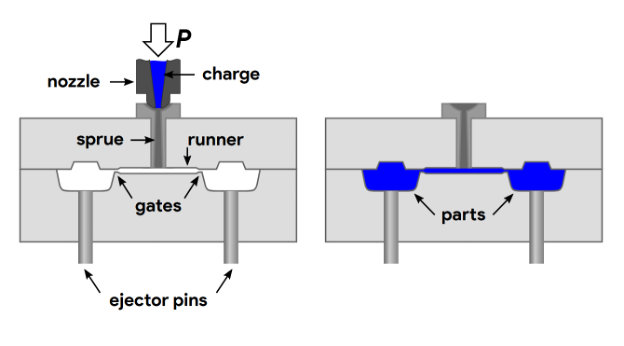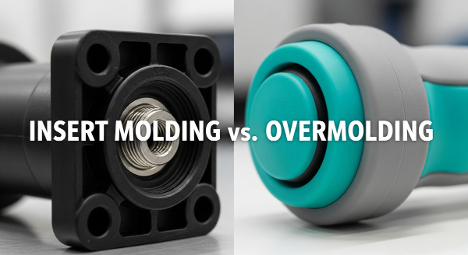Injection molding is the most popular manufacturing process for producing plastic parts. There are wide selection of more than 100 thermoplastic and thermoset materials. Each plastic resin has its unique properties, different strengths and applications that make them ideal for injection molding. This article we will explore different materials for injection molding options.

Here are the 10 most commonly used for plastic injection molding:
- Acrylic (PMMA)
- Acrylonitrile Butadiene Styrene (ABS)
- Nylon Polyamide (PA)
- Polycarbonate (PC)
- Polyethylene (PE)
- Polystyrene (PS)
- Polypropylene (PP)
- Polyoxymethylene (POM)
- Thermoplasitc Elastomer (TPE)
- Thermoplastic Polyurethane (TPU)
Acrylic is also know as PMMA or plexiglass. It is a strong and clear thermoplastic that provides a lightweight, shatter-resistant alternative to glass. This material also offers excellent optical clarity so that a high percentage of light passes through.
The application of acrylic including windows, car screens, solar panels, bathroom enclosures, and other transparent components for architectural, lighting, and outdoor applications.
Advantages of Acrylic
- Transparent
- Tough and durable
- Scratch-resistant
- Resistant to weathering and UV
- Resistant to chemicals(detergents, cleaners, acids, alkalies, hydrocarbons)
- Good dimensional stability
ABS is known for its high-strength and impact resistance. It is an engineering-grade thermoplastic with a relatively low melting point that makes it easy to mold. This opaque polymer supports the use of colorants as well as various textures and surface finishes. It’s butadiene content delivers exceptional toughness, even at low temperatures, and its styrene content imparts a shiny, attractive finish to injection molded parts.
ABS is used in a variety of commercial and industrial applications, including automotive components such as dashboards, wheel covers, auto body parts, electronic components, keyboard keys, protective headgear, plastic wall plates for electrical outlets. As well as used in consumer goods, sport equipment, and industrial fittings.
Advantages of ABS
- Good dimensional stability
- Strong impact resistance
- Strong heat resistance
- High tensile strength
- Low cost
Nylon is a synthetic polyamide(PA). It is one of the most important and mature technical thermoplastics, know for its heat resistance, stiffness and high mechanical stability.There are many kinds of PAs,such as PA6, PA66, PA11, PA12, PA46, PA610, etc. The two most widely used PA are by far PA66 and PA6. They are often extruded to manufacture fibers (textile industry) or films (packaging), or injection molded.
Polyamide (nylon), with high temperature and resistance, is considered to be a high-performance plastic, widely used in automobile and transportation markets, consumer goods, electrical and electronic applications and other fields.
Advantages of PA
- High wear resistance
- High thermal stability
- Good strength and hardness
- High mechanical damping characteristics
- Good sliding properties
- Good chemical resistance
Polycarbonate (PC) plastics are a naturally transparent amorphous thermoplastic, which is extremely hard and strong. They are easily worked, molded, and thermoformed. Polycarbonate also has very good heat resistance and can be combined with flame retardant materials without significant material degradation.
PC is commonly used for plastic lenses in eyewear, in medical devices, automotive components, protective gear, greenhouses, Digital Disks (CDs, DVDs, and Blu-ray), and exterior lighting fixtures.
Advantages of PC
- High transmittance
- Good operating temperature range (-20°C – 140 °C)
- Flame retardant
- Good electric insulation
- Decent abrasion resistance
Polyethylene (PE) is one of the most widely produced plastic in the world. It is a thermoplastic polymer with a variable crystalline structure and a vast range of applications depending on the particular type. Polyethylene is divided into high density polyethylene (HDPE), low density polyethylene (LDPE) and linear low density polyethylene (LLDPE).
- Low-Density Polyethylene (LDPE) is a very flexible material with unique flow properties. LDPE has high ductility but low tensile strength, which is evident in the real world by its propensity to stretch when strained. It is typically used when injection molding laboratory equipment, containers, and bottles. It is also widely used for molding liners for tanks and ponds.
- Linear Low-Density Polyethylene (LLDPE) is very similar to LDPE, but offers added advantages. Specifically, the properties of LLDPE can be altered by adjusting the formula constituents, and the overall production process for LLDPE is typically less energy-intensive than LDPE.
- HighDensity Polyethylene (HDPE) is durable and lightweight thermoplastic with variable structures. HDPE has low-temperature resistance, high tensile strength, good chemical resistance, and excellent electrical insulating properties. HDPE resin is best for large parts that require outstanding physical performance. It is commonly used in corrosion-resistant piping, plastic lumber, packaging, and plastic bottles,etc.
Polystyrene can be a thermoplastic or thermoset material depending on its polymeric arrangement Thermosets cannot be remelted after initial forming, but thermoplastics can be melted and reused many times over. For this reason, thermoplastic PS can be used in injection molding and subsequently recycled.
The two most commonly used kinds of standard solid plastic polystyrene are:
General-purpose polystyrene( GPPS) : GPPS is a hard, brittle homopolymer that is naturally clear but can be colored. Think of a CD plastic jewel case.
High-impact polystyrene( HIPS) : HIPS is opaque, much less brittle than GPPS, and contains a polybutadiene rubber impact modifier. It is typically used in household and food packaging.
Polystyrene(PS) is commonly used in medical, optical, and electrical and electronic applications. With its higher impact strength, HIPS is often used with appliances and equipment. Injection molded GPPS is used in plastic toys, cases, containers, and trays.
Advantages of PS
- Cheap, rigid, transparent, easy to mould and good dimensional stability.
- Good electrical properties, low dielectric loss.
- Excellent resistance to gamma radiation.
Polypropylene is an addition polymer produced using polymerization and with the combination of propylene monomers. High chemical and moisture resistance, flexibility, toughness, and excellent electrical insulation make polypropylene highly suitable for injection molding.
The applications of Polypropylene (PP) including toys, storage containers, sporting goods, packaging, electrical appliances and power tool bodies.
Advantages of PP
- Chemical Resistance
- Elasticity and Toughness
- Fatigue Resistance
- Transmissivity
Polyoxymethylene (POM) is an engineering plastic that is also known as acetal. In terms of appearance, POM plastics are naturally opaque and white in color. Injection molded POM combines excellent rigidity with thermal stability and a low coefficient of friction. It also has low water absorption and good chemical resistance. Two main types of POM plastics are available: homopolymers and copolymers. This gives engineers and designers a choice of acetal materials with different properties.
With its low coefficient of friction, injection molded POM is suitable for bearings, gears, conveyor belts, and pulley wheels. Additional applications include fasteners, eyeglass frames, parts for knives and firearms, lock systems, and high-performance engineering components.
Advantages of POM
- High crystallinity
- Fantastic dimensional stability
- Excellent wear resistance
- Good electrical insulation
Thermoplastic elastomer, also called TPE, are one type of plastic known for its versatility and recyclability. It is a blend of rubber rubber and plastic materials.Known also as thermoplastic rubber (TPR), TPE can be stretched to moderate elongations and, upon the removal of this stress, returns to the material’s original shape.
Thermoplastic elastomer (TPE) material applications are vast, including, but not limited to, use in domestic products such as consumer products, transportation equipment, or any market requiring a grip, pad, bumper, flap, seal, or gasket.
Advantages of TPE
- Cost effective and efficient
- Chemical and UV resistant
- Excellent colorability
- High impact strength
- Good electrical properties
TPU is an elastic thermoplastic material with high abrasion and chemical resistance. Like most elastomers, it’s commonly used for seals, gaskets, and hoses. It can also be found on overmoulded plastic parts due to its ability to add grip or dampen vibration. It’s similar to TPE, but offers more durability for parts that will experience wear and tear.
There are many applications of thermoplastic polyurethane(TPU), including automotive instrument panels, caster wheels, power tools, sporting goods, medical devices, drive belts, footwear, inflatable rafts, fire hoses, and a variety of extruded film, sheet and profile uses.
Advantages of TPU
- High heat resistance
- High liquid resistance
- Low temperature flexibility
- Recyclable
Each plastic resin has its own unique properties. It is important to consider the defining properties of each to choose the right one for your product.
-q4gvl4k29y4hq8j9rjpapvj0ft06fje63olt7p210i.png)


